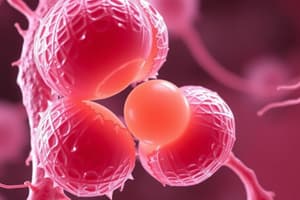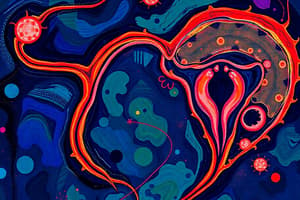Podcast
Questions and Answers
What is the primary function of prophase I in meiosis I?
What is the primary function of prophase I in meiosis I?
- Alignment of chromosomes at the spindle equator
- Separation of homologous chromosomes
- Chromosome condensation, synapsis, and crossing over (correct)
- Separation of sister chromatids
What is the trigger for oocyte maturation and the completion of ovum formation?
What is the trigger for oocyte maturation and the completion of ovum formation?
- Surge of luteinizing hormone (LH) during ovulation (correct)
- Surge of follicle-stimulating hormone (FSH) during ovulation
- Formation of a Graafian follicle
- Release of progesterone from the corpus luteum
What is the result of meiosis I in oocyte development?
What is the result of meiosis I in oocyte development?
- Formation of two diploid cells: a large secondary oocyte and a smaller polar body
- Formation of two haploid cells: a large ovum and a smaller polar body
- Formation of one haploid cell: a large ovum
- Formation of two haploid cells: a large secondary oocyte and a smaller polar body (correct)
What is the stage of meiosis II where chromosomes align at the spindle equator?
What is the stage of meiosis II where chromosomes align at the spindle equator?
What is the fate of the secondary oocyte if it is not fertilized?
What is the fate of the secondary oocyte if it is not fertilized?
What is the cellular origin of oogonia in oocyte development?
What is the cellular origin of oogonia in oocyte development?
Flashcards are hidden until you start studying
Study Notes
Oocyte Development
Oogonium Formation
- Oogenesis begins with the formation of oogonia, which are diploid cells derived from the primordial germ cells
- Oogonia proliferate and grow in the embryonic ovaries
Meiosis I
- Oogonia undergo mitosis to produce primary oocytes
- Primary oocytes enter meiosis I, which consists of:
- Prophase I: chromosome condensation, synapsis, and crossing over
- Metaphase I: alignment of chromosomes at the spindle equator
- Anaphase I: separation of homologous chromosomes
- Telophase I: chromosomes move to opposite poles
- Meiosis I results in the formation of two haploid cells: a large secondary oocyte and a smaller polar body
Meiosis II
- Secondary oocyte arrests in metaphase II
- Meiosis II is completed only if the oocyte is fertilized
- Meiosis II consists of:
- Metaphase II: alignment of chromosomes at the spindle equator
- Anaphase II: separation of sister chromatids
- Telophase II: chromosomes move to opposite poles
- Meiosis II results in the formation of a haploid ovum and a second polar body
Oocyte Maturation
- Oocyte maturation involves the resumption of meiosis II and the completion of ovum formation
- Oocyte maturation is triggered by the surge of luteinizing hormone (LH) during ovulation
- The mature ovum is released from the ovary and travels through the fallopian tube, where it can be fertilized by a sperm
Oocyte Development
Oogonium Formation
- Oogonia are diploid cells derived from primordial germ cells, which proliferate and grow in embryonic ovaries
Meiosis I
- Primary oocytes are formed from oogonia through mitosis
- Primary oocytes undergo meiosis I, consisting of:
- Prophase I: chromosome condensation, synapsis, and crossing over
- Metaphase I: alignment of chromosomes at the spindle equator
- Anaphase I: separation of homologous chromosomes
- Telophase I: chromosomes move to opposite poles
- Meiosis I results in two haploid cells: a large secondary oocyte and a smaller polar body
Meiosis II
- Secondary oocyte arrests in metaphase II
- Meiosis II is completed only after fertilization, consisting of:
- Metaphase II: alignment of chromosomes at the spindle equator
- Anaphase II: separation of sister chromatids
- Telophase II: chromosomes move to opposite poles
- Meiosis II results in the formation of a haploid ovum and a second polar body
Oocyte Maturation
- Oocyte maturation involves the resumption of meiosis II and ovum formation
- Oocyte maturation is triggered by the luteinizing hormone (LH) surge during ovulation
- The mature ovum is released from the ovary and travels through the fallopian tube for possible fertilization
Studying That Suits You
Use AI to generate personalized quizzes and flashcards to suit your learning preferences.



